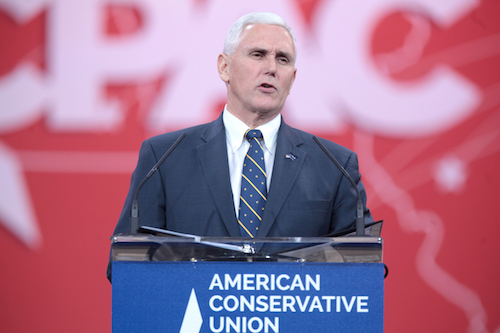Vice President Mike Pence was
governor of Indiana in 2015 when the state’s GOP-dominated Legislature passed a
repeal of the state’s prevailing wage laws, arguing the measure would save
taxpayers money without cutting workers’ salaries.

|
Vice President Mike Pence speaking at the Conservative Political Action Conference in 2015. Pence was the governor of Indiana at the time and leading an assault on the state's common wage laws.
Photo provided under a Flickr/Creative Commons agreement by Gage Skidmore.
|
But a new analysis proves he was wrong, just as the IBEW and other advocates for working families warned he would be.
The study, from the non-partisan Midwest Economic Policy Institute, found that skilled Indiana construction workers saw their wages fall by an average of 8.3 percent since the law was passed. Lower-skilled construction workers saw their wages fall 15.1 percent. The study looked at the wages of all workers, not just union members.
That was no surprise to IBEW members who tried to convince the Legislature the move was aimed to please far-right corporate interests and Pence’s campaign donors, not Indiana’s citizens – and especially not its working families.
“Those were the things we tried to get across to the legislators when they were doing this,” said Evansville, Ind., Local 16 Business Manager Paul Green. “They weren’t going to listen because, quite frankly, the reasons for it weren’t to save money.”
Neighboring Illinois, Michigan and Ohio – which have prevailing wage laws – saw their wages grow a combined 2.8 percent over the same period, according to the report.
“The early data from Indiana is unambiguous and confirms what most peer-reviewed economists have been saying for decades,” Kevin Duncan, a professor of economics at Colorado State University-Pueblo and one of the report’s authors, told the Times of Northwest Indiana.
“Repeal of prevailing wage laws does not save taxpayer dollars, but it shrinks middle-class paychecks, hurts the economy and causes problems ranging from lower productivity to higher turnover for the construction industry.”
Prevailing wage laws called common wage in Indiana, guarantee pay rates and conditions of employment on public works projects and help them come in on time and under budget. Wage rates are based on an average pay for construction workers in that area and do not inflate costs.
They also help contractors avoid hiring out-of-state, low-skilled workers who are paid less and more easily exploited. That helps keep more tax money in the local jurisdictions and improves the lives of working families.
Pence is a longtime benefactor of far-right interest groups that haven’t hidden their disregard for labor. He pushed hard to get the law passed in Indiana, along with help from the Associated Builders and Contractors, a group of nonunion contractors and affiliates that has lobbied repeatedly for legislation that harms working families.
“It’s just a big smokescreen,” said Indianapolis Local 481 Business Manager Steve Menser. “It was all political. They just wanted to carve out one more thing that would hurt unions.”
The law passed 27-22 in the Senate, even though 12 Republicans joined with Democrats to vote against it. It passed the House 54-45.
“By repealing the common construction wage, our state is putting hardworking taxpayers first, lessening the burden on cash-strapped local governments and schools and opening the door of opportunity for small business across our state,” Pence said at the time.
The reality hasn’t matched Pence’s rhetoric. The policy institute reported the cost of 335 school projects in 14 northwest Indiana counties actually increased since the law was passed. The authors noted it was difficult to draw statewide conclusions because of the absence of bid data in other areas.
Menser is a member of a school board in suburban Indianapolis where a school is now being remodeled by a nonunion contractor.
“We didn’t have any union contractors bid that project,” he said. “I think a lot of our contractors are looking at the smaller school jobs and don’t see themselves being competitive, so why waste time on the bidding?”
Green noted Local 16 has members working on a new middle school in Evansville, adding that a longtime positive relationship with the school board there helped land it.
“Under the competitive bid process, we still got the work,” he said. “That tells me the nonunion contractor is not as efficient or he’s padding his pocket due to the repeal of the common construction wages.”
Other notable points from the institute’s report include:
--Employment growth in public works construction was 1.5 percentage points lower in Indiana than in Illinois, Michigan and Ohio.
--Construction workers’ productivity in Indiana grew 5.3 percent less than in Illinois, Michigan and Ohio.
--The share of construction workers who were military veterans fell 1.2 percent in Indiana. The report noted that veterans working in construction tend to be younger and received formal job training while serving. Keeping them employed is crucial in an aging industry.
“Everything we predicted is true,” Menser said. “The productivity is low and turnover is high.”
Things aren’t expected to change much in the near future in Indiana, where the GOP still has a supermajority in the statehouse. But the debate over prevailing wage laws continue in Michigan, Ohio and several other states, and labor activists will point to Indiana’s failures as a warning. Legislation also has been filed in Congress to abolish them on the federal level.
Arkansas and Kentucky repealed their prevailing wage laws last year and West Virginia did so in 2016, bringing the total number of states without them to 22.
“Much of the focus has been on right-to-work laws, but the news from Indiana shows the eradication of prevailing wage laws has been just as destructive to our Brotherhood,” said International President Lonnie R. Stephenson. “It hits our members in the pocketbook and drains local communities of needed tax revenue. We must continue to remind politicians why such laws exist and how they benefit all workers.”
A copy of the institute’s report can be found here.